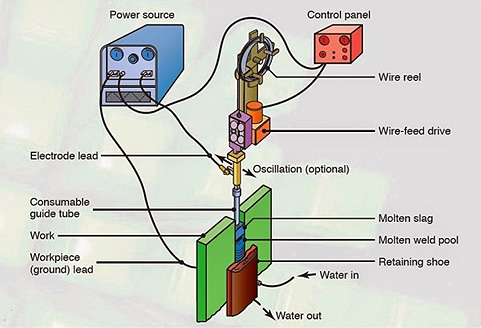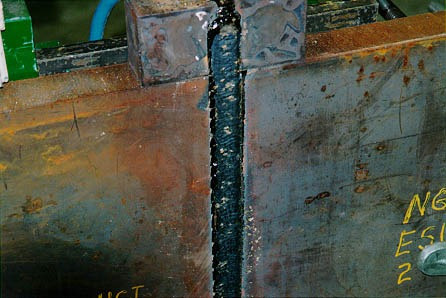Electro-Slag Welding (ESW) of Steels: Part One
Abstract
Electro-slag welding (ESW) represents a primary welding method for cast weld assemblies of heavy sections, distinguished by its exceptionally high deposition rate. This single-pass process offers significant advantages including weld symmetry, high welding speed, simplified joint preparation, and low flux composition requirements. The ESW process shares characteristics with submerged-arc welding, utilizing continuous bare electrode wire feeding into a molten slag pool contained between water-cooled dams in vertical position welding. While offering substantial benefits for thick section applications, the process presents limitations including restricted positioning and potential grain coarsening effects that must be carefully considered in industrial applications.
Introduction to Electro-Slag Welding Technology
Electro-slag welding stands as a revolutionary welding technology specifically designed for joining heavy steel sections through a unique process that combines high efficiency with exceptional deposition rates. This advanced welding method has transformed the approach to welding thick materials across various industrial sectors.
Process Fundamentals and Operating Principles
The electro-slag welding process demonstrates remarkable similarities to submerged-arc welding, particularly in its application for vertical position welding operations. The method employs bare electrode wires that feed continuously into a carefully maintained molten slag pool, which remains contained between strategically positioned water-cooled dams.
The ESW process initiates through arc formation to melt the flux and establish a molten slag pool. Once this initial phase completes, the arc extinguishes, and the system maintains a molten pool comprising both weld metal and base metal through heat generation. This heat results from the electrical resistance encountered by the flux during current passage from the electrode to the base metal. As the water-cooled dams move upward progressively, the metal undergoes controlled solidification, creating the final weld structure.

Figure 1: Schematic of the ESW-electroslag welding process
Historical Development and Evolution
The electro-slag welding process originated in the United States during the late 1930s, with comprehensive documentation provided through a series of foundational patents (Hopkins 1940). Subsequently, the technology underwent significant advancement at the E.O Paton Institute in Kiev, Ukraine, where researchers successfully demonstrated its exceptional capability for joining thick section steels and various other materials.
Industrial Applications and Use Cases
The ESW process proves particularly valuable for cast weld assemblies involving heavy sections, primarily due to its exceptionally high deposition rates. These superior deposition characteristics, combined with minimal joint preparation requirements, position the process as an ideal solution for extensive weld repairs in carbon and low alloy steel applications. However, operational constraints limit the process exclusively to vertical position welding.
Primary Application Areas
ESW technology finds extensive application in structural box columns and wide flange construction projects. The manufacturing sector utilizes this process extensively for large presses and precision machine tools. Additional machinery applications encompass industrial kilns, gear blanks, motor frames, press frames, turbine rings, shrink rings, and crusher bodies. The process also proves invaluable for rebuilding metal mill rolls and manufacturing rims for road rollers. Furthermore, pressure vessel fabrication for chemical, petroleum, marine, and power generating industries relies heavily on ESW technology.
Process Advantages and Benefits
Electro-slag welding delivers extremely high deposition rates while requiring only a single pass regardless of workpiece thickness. Unlike submerged arc welding (SAW) and other conventional arc welding processes, ESW eliminates angular distortion through its symmetrical weld configuration relative to the axis. The process achieves high welding speeds while ensuring excellent stress distribution across the weld zone.
Joint preparation requirements remain significantly simpler compared to alternative arc welding processes. The technology generates minimal residual stresses and distortion, contributing to superior final product quality. Additionally, flux composition requirements prove substantially lower than those required for submerged arc welding operations.
Process Limitations and Considerations
High heat input conditions can compromise weld quality, potentially resulting in reduced toughness due to coarse grain formation in both the fusion zone and heat-affected zone. ESW operations demonstrate some susceptibility to hot cracking and notch sensitivity within the heat-affected zone.
Logistical constraints restrict ESW exclusively to vertical position welding due to the substantial molten metal pools and slag volumes involved. The process presents challenges when attempting to close cylindrical welds. Electro-slag welding characteristically produces large grain sizes, which may impact material properties. For joints below 60 mm thickness, submerged arc welding proves more economical than ESW.

Figure 2: ESW welds
Conclusion
Electro-slag welding represents a specialized yet highly effective welding technology for specific industrial applications involving thick steel sections. While the process offers substantial advantages in terms of deposition rates and single-pass capability, careful consideration of its limitations ensures optimal application selection and successful project outcomes.
Find Instantly Thousands of Welding Materials!
Total Materia Horizon contains thousands of materials suitable for welding and electrodes, with their properties in bulk and as welded conditions.

Get a FREE test account at Total Materia Horizon and join a community of over 500,000 users from more than 120 countries.